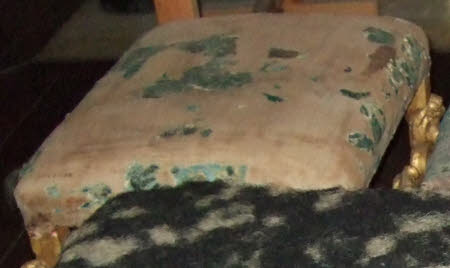Stool
attributed to Thomas Roberts
Category
Furniture
Date
Aug 1688 - Nov 1688
Materials
carved and gilded walnut covered in Genoa silk velvet
Measurements
55.0 x 71.0 x 60.0 cm
Place of origin
'The Royal Chair', Marylebone Street, Westminster, London, England
Order this imageCollection
Knole, Kent
NT 129449.1
Summary
One of a set of six gilt walnut stools, each with four standing figures and carved scroll stretchers, and covered with blue-green Genoa velvet, trimmed with a russet tasselled fringe. The stools are part of a larger set of upholstered furniture around a highly significant state bed (129447) ordered by the Great Wardrobe for James II’s apartments at Whitehall Palace in August 1688 and forming one of the most spectacular and historically important sets of late Stuart furniture in existence. The set further comprises two matching armchairs (129448.1 and 129448.2). The carving, including that of the bed and chair frames, was almost certainly executed by the joiner, carver and official royal chair maker Thomas Roberts, who supplied the royal household with bed frames, seat furniture and miscellaneous items from 1686 onwards. The revolutionary events surrounding James II sudden departure from England in December 1688 may explain why the subsequent Wardrobe accounts, which might have revealed the name of the upholsterer, were never made up. The Huguenot Jean Poitevin is perhaps the most likely candidate, since he received most of the other large commissions of this sort during James II’s brief reign. Because it bears the cipher of James II, the bed was ‘entirely unsuitable for the new monarchs, William and Mary’, as Olivia Fryman put (Fryman 2014). Therefore, the bed and its matching seat furniture must have been virtually new and untouched when Dorset claimed it as his perquisite around 1694.
Provenance
Acquired as a royal perquisite by Charles Sackville, 6th Earl of Dorset in his capacity of Lord Chamberlain around 1694; first brought to Copt Hall, then to Knole in about 1701, where first recorded in 1706. Knole and the majority of its furniture were accepted by HM Treasury in part payment of death duties and transferred to the National Trust in 1946.
Makers and roles
attributed to Thomas Roberts, chairmaker probably Jean Poitevin, upholsterer
References
Fryman 2011: Oliva Fryman, Making the bed: the practice, role and significance of housekeeping in the royal bedchambers at Hampton Court Palace 1689-1737 (PhD thesis), Kingston University Fryman 2014: Olivia Fryman, 'Rich Pickings: The Royal Bed as a Perquisite, 1660-1760', Furniture History L (2014): 119-36
